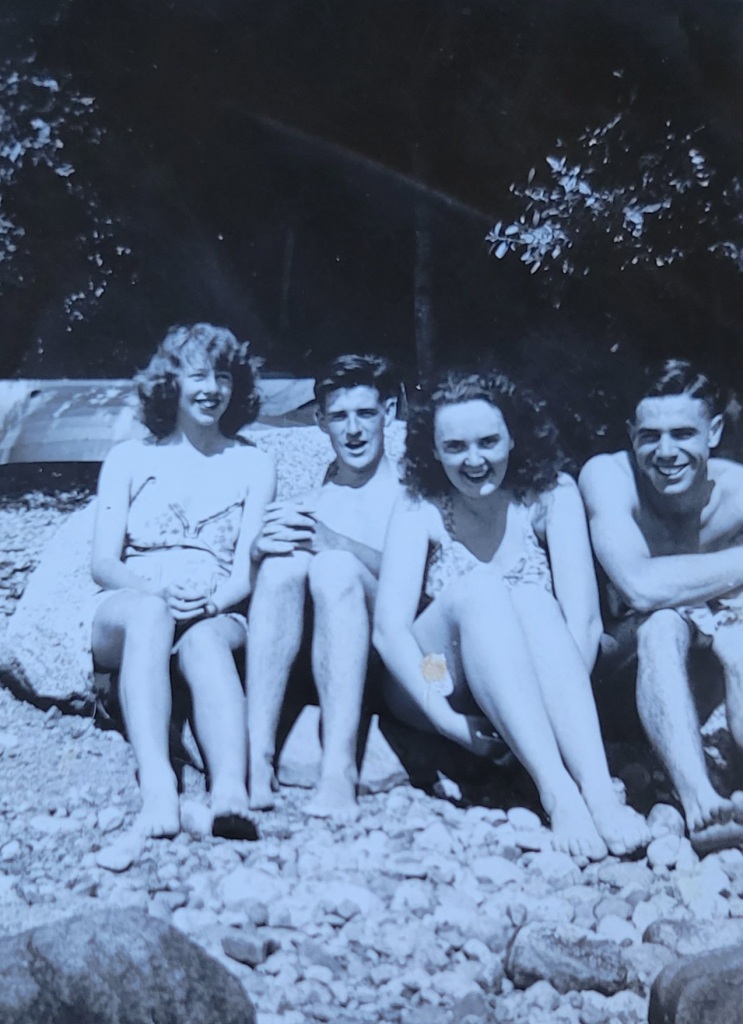I was in the kitchen I think, when Mom walked in with her old knitting bag. She pulled out a ball of variegated sock yarn and behind that, three needles carrying a tangle of stitches. The fourth needle dangled from their midst. It was heartbreaking. After she couldn’t read anymore, she could still knit. And she did. Socks for her grandsons. But now she couldn’t, not even the socks she’d been knitting for decades. Stitches dropped, yarn carried across the gaps, needles turned so the most important part of a sock, the hole into which you place your foot, was gone. I almost cried. There was so little left.
Just a few months earlier, she was still able to knit if I was nearby. She knew when something went wrong. She knew, but couldn’t see what it was or figure out what to do. I’d take it from her, fix it up and hand it back. Watch for a moment to see she was back on track. Together, we’d also been able to finish a huge blanket she made for one of her grandsons, Chris. She gave it to him just a couple of months before she died. We had so much knitting fun over the years, visiting wool shops, sitting together knitting, talking about patterns.
I just read an Ann Patchett essay, How Knitting Saved My Life. Twice, in which she describes how she’d come back to knitting when travelling in Ireland. When she made a mistake, she’d hand her knitting to any woman who happened to be nearby and ask for help. They could always fix it, she said, and if they had time they’d teach her how to fix it. I remember Lynn, when he was learning and I wasn’t nearby, going into yarn shops and asking for help. Always freely given.
It wasn’t until I was going through Mom’s belongings after she died in September that I came across her sock pattern. She never referred to unless it was time to turn the heel. Over the years, how many times did I hear that phrase, just wait until I’ve turned the heel? It required concentration and careful counting. My heart broke all over again to see the raggedness of the paper onto which the pattern had been glued how many years ago? The pattern calls for P.K. Victory Fingering Yarn and must have dated back to the 1940s, when girls knit socks for soldiers. It refers to Maitland Spinning Mills, Ltd. Listowel, Ontario. A division of Mercury Milled Limited. Hamilton, Canada. She’d likely have knit a few socks back then, for she knew men who were overseas fighting. One, Leslie McLean, whose letters I found in a box tucked away in a drawer in her bedside table, was killed in action in 1944.
I don’t recall her knitting much when I was a kid. My grandma did, and she could make the needles clack, she was so fast. The socks just whizzed off her needles. I tried using her old steel needles and the knitting belt an admirer made for her, but was never fast enough to make them sing.
When Mom lived on Vancouver Island in the late 1940s, she and her best friend Flo rode their bikes from Victoria to Powell River. Did they ride them back too? Did they take a Union Steamship across? I never did get the story straight. But for the next 70 years they visited back and forth and exchanged patterns and wool and went out for a Dairy Queen Blizzard whenever they were together.
But just as she lost her sight, she’d lost many of those memories unless you found the right questions to ask. Always tricky, that. Finding the right questions. And now we’ve lost her too.
It’s hard remembering her walking into the kitchen that morning, wanting to knit, and not being able to help her. I feel now, I should have let her knit up that tangle, fixed it as best I could and let it grow and grow. Since I can’t do that, I’ve taken up the wool and the needles a friend gave to her a couple of years ago, and am knitting up the socks, following the old pattern. These are for her great-grandson.





